Ever found yourself staring at your hiking boots, thinking, “Can I really strut these on the pavement without looking like a complete newbie?” Or, “Are Hiking Boots Good for Walking on Pavement?”
Yeah, I get it. You’ve just come down from the mountain, and the city streets are calling. But there’s that nagging voice in your head: “What if these boots aren’t cut out for the concrete jungle? What if they wear out faster, or worse, make my feet scream in agony?”
Hey, it’s totally okay to have those jitters. We’ve all been there, wondering if our trusty hiking companions can double up for those urban adventures.
But guess what? You’re not alone in this, and I’ve got your back.
Together, we’ll dive deep into the pros and cons, unravelling this footwear mystery.
Ready to kick those doubts to the curb? Let’s begin.
Tracing the Journey: Hiking Boots Through Time
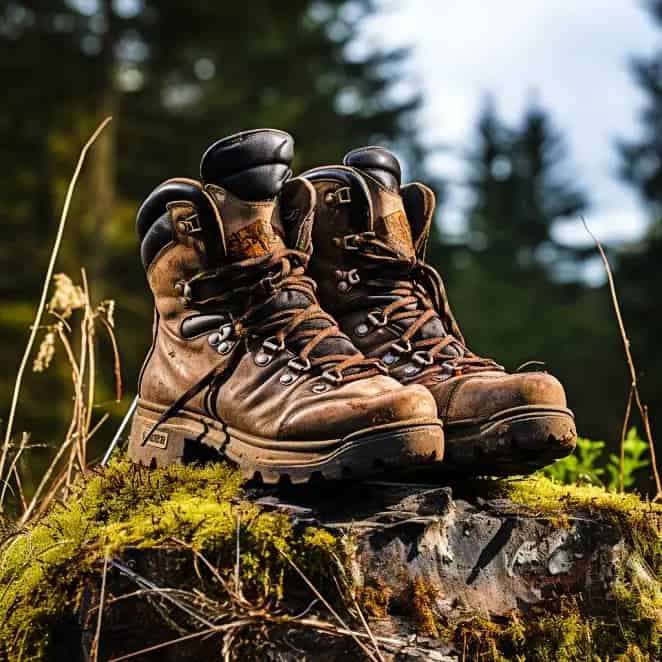
Hiking boots, those trusty companions of many an adventurer, have a rich history. Born out of necessity, the makers crafted them to tackle the unpredictable challenges of the wild.
From the early days when explorers sought to conquer uncharted territories, these boots were their shield against sharp rocks, slippery surfaces, and rough terrains.
The primary purpose? To protect the feet and offer stability.
Over the years, as technology advanced and materials evolved, hiking boots transformed. From leather soles to rubber ones; from heavy designs to lightweight versions, they’ve adapted.
Today, they’re not just confined to mountain trails but have made their way onto city streets.
But can they really transition from hiking trails to walking on pavement? Let’s find out.
Hiking Boots vs. Walking Shoes: The Key Distinctions
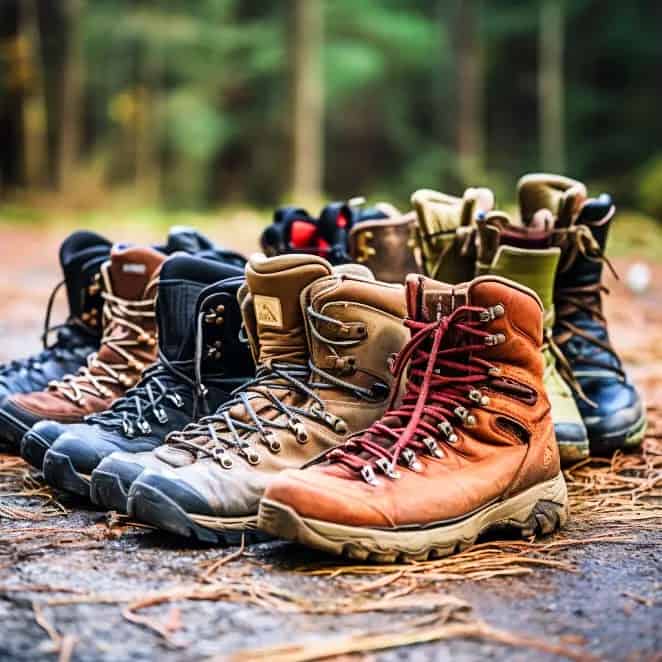
When you place a hiking boot next to a walking shoe, the visual differences are clear.
Hiking boot brands design them to be sturdy, and to conquer the wild. They’re the tanks of the footwear world, built to withstand the challenges of nature.
Their thick rubber soles are crafted to provide extra traction, essential when navigating slippery slopes or rocky terrains.
The high ankle design? That’s to offer the much-needed ankle support, making sure you don’t twist your foot when treading on uneven grounds.
Walking shoes, on the other hand, are the sedans of the footwear universe.
Designed for comfort, they’re perfect for those leisurely strolls in the park or daily commutes. They’re lightweight, flexible, and prioritise ease of movement.
The soles are softer, designed for flat surfaces rather than rugged terrains. The low-cut design offers freedom of movement but lacks the ankle support provided by hiking boots.
So, while they design both for movement, their intended use is worlds apart. It’s like comparing a rugged off-roader to a city car. Both serve a purpose, but their functionalities differ vastly.
Why Hiking Boots Shine on City Streets
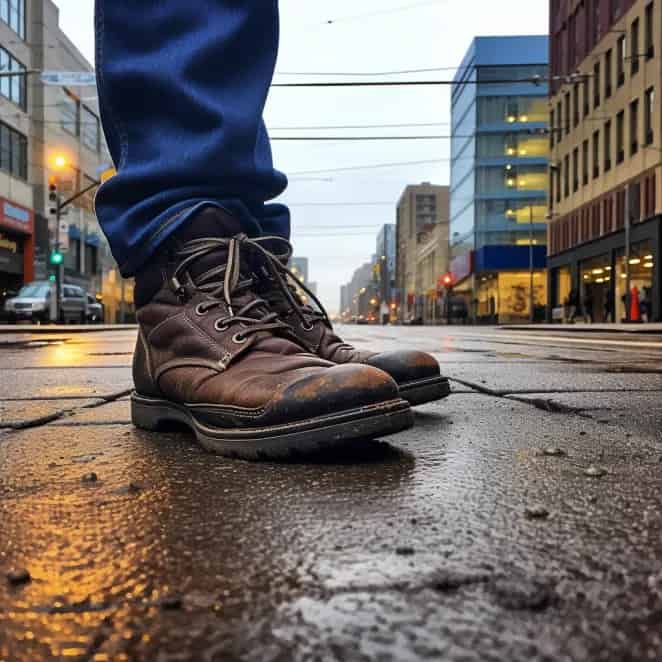
Ever gazed at your hiking boots, wondering if they’re good for more than just the trails?
Navigating city streets isn’t just about style; it’s about substance.
When you’re walking on concrete day in and day out, you need footwear that’s up to the task.
Those city pavements can be unforgiving, but with the right pair of boots, every step can feel like a walk in the park.
Ready to uncover the urban prowess of hiking boots? Let’s step right in!
- Comfort: Ever walked a mile in uncomfortable shoes? It’s torture, right? Hiking boots, with their cushioned interiors, are like a protective cocoon for your feet. They shield you from those tiny pebbles or uneven patches on the pavement. The thick soles absorb shocks, making sure every step is a comfortable one.
- Durability: These boots are warriors. Originally designed for the unpredictable wild, they can easily handle the challenges of city streets. The robust construction means they won’t wear out easily, even with daily use on concrete.
- Versatility: Imagine owning a pair of shoes that’s perfect for both mountain trails and urban adventures. That’s the beauty of hiking boots. They’re versatile, removing the need to switch between different pairs for different terrains.
- Style: There’s a rugged charm to hiking boots. Wearing them in an urban setting makes a statement. It speaks of adventure, of a spirit that’s unafraid to tread the unknown. Plus, they can be quite the fashion statement when paired right.
- Cost-Efficiency: Think long-term. Investing in a durable pair of hiking boots might seem expensive initially. But when you consider their longevity and versatility, they’re a cost-effective choice. Instead of buying multiple pairs of shoes for different purposes, one good pair of hiking boots can serve multiple needs.
Hiking boots aren’t just for the trails anymore.
With their robust build and unparalleled support, they’ve found a home on the bustling streets of the city.
Their thick soles, designed to tackle rough terrains, provide a cushion against hard concrete, making sure every step is a comfortable one.
Plus, their high-ankle design offers that extra bit of support, making long city walks a breeze.
And let’s not forget the style statement they make; rugged yet refined. They’re the perfect blend of outdoor adventure and urban chic.
But as with all things, it’s not all sunshine and rainbows. While hiking boots have their shining moments on city streets, they come with their own set of challenges when treading on urban grounds.
Potential Pitfalls of Pavement Prowling in Hiking Boots

Ah, the allure of strutting down city streets in those rugged hiking boots!
But wait! Before you confidently tread into the urban jungle, let’s chat about some potential hiccups.
Just as every rose has its thorns, even the sturdiest hiking boots might have a few quirks when they hit the pavement.
Ready to uncover what lies beneath those tough exteriors? Let’s dive into the potential pitfalls of pavement prowling in your trusty hiking boots.
- Wear and Tear: Here’s the thing. While hiking boots are durable, the constant friction against concrete can wear them down faster than natural trails. The rough texture of pavements can erode the soles, reducing their lifespan.
- Potential Discomfort: Hiking boots are for rough terrains. This aspect means they might feel a tad overboard for a simple pavement walk. The thick soles, while protective, can make the feet feel trapped, leading to overheating, especially during summers.
- Appearance: Let’s face it, hiking boots have a distinct look. In certain urban settings, they might stand out, and not always in a good way. While some might appreciate the rugged look, others might find it out of place.
- Weight: They’re undeniably heavier than your average walking or running shoe. This added weight can be a downside for some, especially during long walks on pavements.
- Cost: Quality comes at a price. Good hiking boots don’t come cheap. The initial investment might be higher than regular walking shoes, making some think twice before taking the plunge.
Hiking boots, with their rugged charm and sturdy build, might seem like the perfect companion for any terrain.
But when it comes to the smooth, unyielding surfaces of city pavements, there are a few hitches to consider.
The urban jungle has challenges, like accelerated wear and tear and potential discomfort.
And while these boots are champions on uneven, wild trails, the city streets might just be their kryptonite.
But hey, don’t just take my word for it!
Real Stories: Hikers Share Their Pavement Tales

Ever wondered how those rugged hiking boots fare on city streets? Well, you’re not alone. Dive into real-life adventures as fellow hikers spill the beans on their pavement escapades.
- Jane, an avid hiker, recalls her experience, “I once wore my hiking boots for a whole day in the city. They were comfy, but by evening, my feet felt a bit warm. However, I loved the extra traction they provided, especially on slippery pavements after a rain.”
- Mike, on the other hand, shares a different perspective, “I love the rugged look of my hiking boots. I’ve worn them to casual outings in the city, and they’ve always been conversation starters. Plus, the grip they offer is unmatched. I remember once when I was caught in a downpour; while others were skidding, my trusty boots kept me stable.”
Every hiker has a tale to tell, and when it comes to city strolls in those trusty hiking boots, the stories are as diverse as the trails they’ve conquered.
From the bustling streets of New York to the serene pathways of Kyoto, hikers have tested the mettle of their boots on pavements worldwide.
Some swear by the comfort and support, while others have faced the occasional hiccup.
But these tales, filled with adventures and misadventures, bring us to an essential question: Are there other footwear options better suited for our urban escapades?
Exploring Other Footwear Options for City Walks
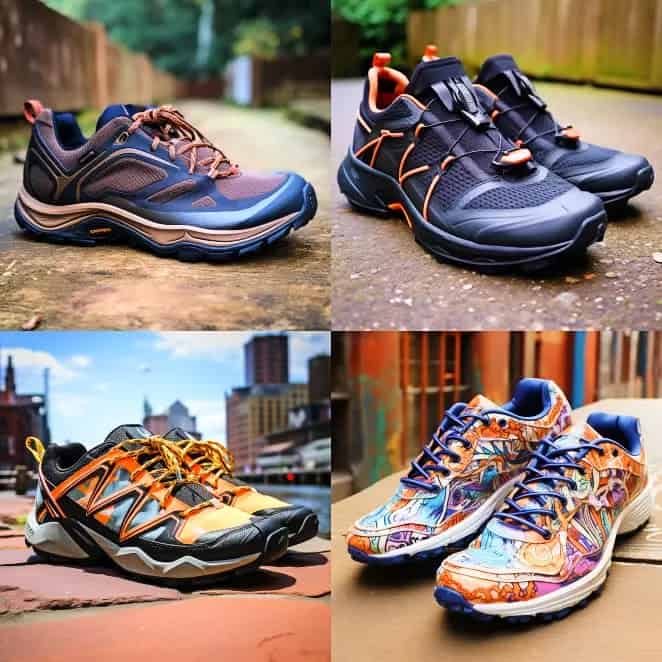
Ever thought about why many urban explorers wear hiking shoes even when they’re miles away from the nearest trail?
It’s not just a fashion statement. It’s about merging the ruggedness of the wild with the demands of the urban jungle.
It’s about being ready for any adventure, be it on a mountain trail or a city sidewalk.
Lacing up for a city stroll?
While hiking boots have their charm, they’re not the only players in the game. Let’s saunter through some other footwear options tailored for those urban adventures.
Ready to step into some alternatives? Let’s go!
Trail Running Shoes: These are the perfect middle ground. They offer the grip of hiking shoes combined with the lightness of a running shoe. Designed for trails, they’re equally adept at handling city pavements. The soles, while providing grip, are flexible, making them perfect for those pavement adventures.
Walking Shoes: If you’re looking for something lightweight for daily use, walking shoes are your best bet. They design them for comfort, making sure your feet remain fatigue-free even after long hours of walking. The soft soles are perfect for flat surfaces, offering the right balance between cushioning and flexibility.
Hybrid Shoes: The modern solution to an age-old dilemma. Hybrid shoes are for both terrains in mind. They offer the sturdiness of hiking shoes combined with the comfort of walking shoes. It’s like having the best of both worlds.
City streets have their own rhythm, a unique beat that’s different from the wild trails.
While hiking boots bring their own set of advantages, it’s essential to recognise that there’s a whole world of footwear designed specifically for urban terrains.
From breathable sneakers to cushioned walking shoes, the city offers a plethora of options tailored for its flat, even surfaces.
These alternatives promise comfort, style, and the ease of blending in with the urban crowd.
But what if your heart is set on those rugged hiking boots, and you’re itching to make them your city-walking companion?
Well, it’s all about making smart choices.
Smart Choices: Picking Hiking Boots for Urban Adventures

Stepping onto the urban scene with hiking boots?
It’s not as wild as it sounds! Navigating city streets requires footwear that’s both stylish and sturdy. But how do you pick the perfect pair that marries trail toughness with city chic?
Let’s face it: no one wants to end their day with sore feet. That’s why investing in comfortable shoes is a no-brainer.
Whether you’re trekking up a hill or just running errands in the city, your feet deserve the best. After all, happy feet lead to happy adventures!
Dive into our guide on making smart choices for your urban adventures.
Let’s lace up and explore!
- Proper Fit: I can’t stress this enough. A well-fitting boot can be the difference between a comfortable walk and a day of foot pain. Make sure your boots fit snugly, but not too tight. Remember, comfort is paramount.
- Maintenance: Hiking boots, especially when used on pavements, need regular care. Clean them regularly to remove dirt and grime. Consider using a protective spray to shield them from water and increase their lifespan.
- Style Tips: Who says hiking boots can’t be stylish? Pair them with jeans or cargo pants for a chic urban look. Throw in a leather jacket, and you’re ready to rock the rugged urban adventurer look.
Navigating the urban jungle with the spirit of a mountaineer?
It’s a unique blend of adventure that demands the right gear.
When choosing hiking boots for city escapades, it’s not just about style; it’s about merging the ruggedness of the trails with the unpredictability of city terrains.
Consider factors like comfort, durability, and the boot’s adaptability to both wet and dry pavements.
Remember, the city is as much an adventure as any mountain trail, and the right boot can make all the difference.
Not all shoes are created equal. Some are made for style, some for speed, but the best shoes good for walking?
They combine comfort, durability, and a touch of flair. Because why should you compromise style for substance when you can have both?
Whether you’re on a trail or a treadmill, make every step count.
But what exactly goes into crafting that perfect hiking boot?
What elements combine to give it the versatility to transition from rocky paths to concrete streets seamlessly?
Diving Deep: What Makes a Hiking Boot?
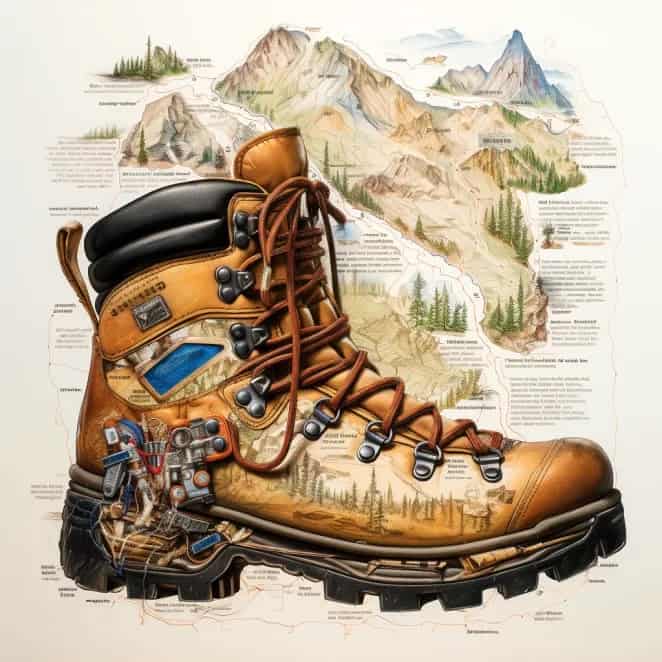
Ever wondered how shoes are designed to handle different terrains?
It’s a blend of science, art, and a dash of adventure. From the grip of the sole to the support of the ankle, every detail is crafted with a purpose.
And when design meets durability, you know you’ve got a winner.
It’s not just about stitching and rubber; it’s an art, a science, and a bit of adventure all rolled into one.
Let’s peel back the layers and dive deep into the anatomy of these rugged companions.
Ready to unravel the mystery of what makes a hiking boot tick? Let’s jump in!
- Sole Composition: The sole is where the magic happens. Designed to offer grip, it’s crafted to make sure every step is stable, be it on a slippery slope or a wet pavement. The rubber composition provides the necessary traction, making sure you remain grounded.
- Upper Material: The upper part of the boot plays a crucial role in its overall comfort. Materials like leather offer durability but might feel a bit restrictive. Synthetic materials, on the other hand, offer more flexibility.
- Ankle Support: One of the standout features of hiking boots is the high ankle design. It’s not just for show. The design makes sure your ankle remains supported, reducing the chances of twists or sprains.
Hiking boots aren’t just another pair of shoes; they’re a marvel of design and engineering.
Crafted to withstand the unpredictable wilderness, they come with features that cater to both comfort and durability.
Hiking boots have different parts for different purposes, like the soles that grip well, or the high ankle that makes sure every step is steady.
The materials, leather or synthetic, are tough against weather and comfortable for feet. The cushioning keeps you from getting tired on long walks.practises
But here’s the kicker: while these boots are designed for the wild, how do they fare on the flat, hard surfaces of our urban jungles?
Does the same design that protects your feet against sharp rocks and rough terrain serve you well on pavements?
Or could there be unforeseen health implications?
Walking the Health Line: Boots on Pavement
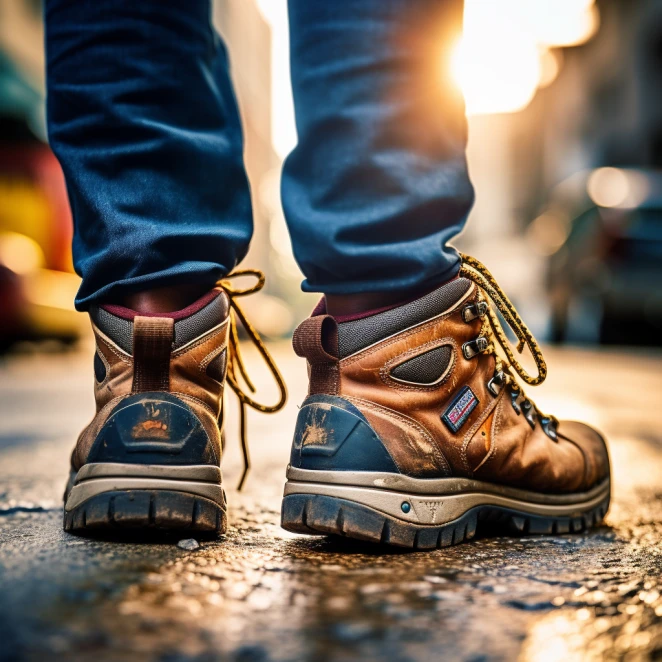
Stepping out and feeling the rhythm of the city beneath your feet is an experience, right?
But here’s the kicker: the shoes you wear can make or break that vibe.
As we tread the line between health and style, let’s delve into how strutting in hiking boots on pavement might just impact your well-being.
- Foot Health: While hiking boots offer unparalleled protection, wearing them constantly on pavement might not be ideal for foot health. The rigid design might not offer the flexibility needed for flat surfaces, leading to potential foot issues.
- Posture and Gait: Every shoe influences the way we walk. Hiking boots, with their distinct design, can influence your walking posture. It’s essential to make sure they don’t adversely affect your natural gait, especially when used on flat surfaces like pavements.
When it comes to our health, every step counts, especially when we’re pounding the pavement.
Hiking boots, with their robust design, offer unparalleled support, making sure our feet and posture remain in tip-top shape.
But it’s not just about foot health.
The right footwear can influence our overall posture, gait, and even our mood as we navigate urban terrains.
So, while you’re taking care of your health with every step, have you ever paused to think about the health of our planet?
Treading Lightly: The Eco-Footprint of Hiking Boots
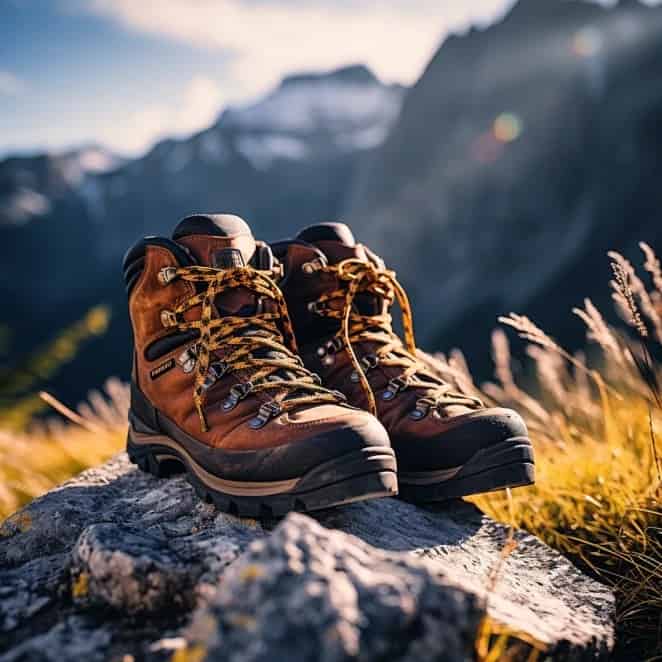
Ever paused mid-stride to look at the mark your boots leave on Mother Earth?
It’s not just about the footprints on the trail, but the environmental trail they leave behind.
Let’s delve into the eco-footprint of those trusty hiking boots and see how we can tread a bit more lightly.
- Carbon Footprint: Every product we use has an environmental impact. Producing one durable pair of hiking boots might have a lesser carbon footprint than manufacturing multiple pairs of less durable shoes.
- Sustainability: In today’s age, sustainability is key. Brands like Patagonia and Merrell are focusing on sustainable production, making sure their products are eco-friendly. It’s a win-win for both nature and us.
Seasonal Shifts: Adapting Boots to Weather Changes
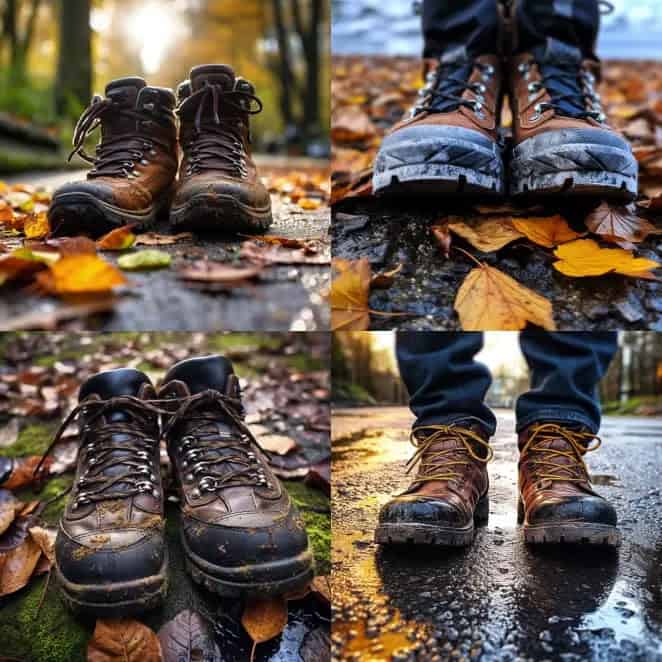
As the seasons change, so do the demands on our trusty hiking boots. Whether it’s the sweltering heat of summer or the icy grip of winter, each season presents its own set of challenges.
It’s essential to make sure that our boots are up to the task, providing comfort and protection regardless of the weather.
Let’s delve into how to adapt and care for our boots as the calendar pages turn.
- Summer: The warm months pose a unique challenge. Breathability becomes crucial. The last thing you want is sweaty feet. Some hiking boots come with breathable materials, making sure your feet remain cool even in the heat.
- Winter: Cold months bring their own set of challenges. Insulation becomes paramount. Some hiking boots are designed with insulation, making them perfect for those chilly days. Plus, they can be quite handy in snowy urban settings, offering the necessary grip.
- Rainy Season: Wet pavements can be slippery. Waterproofing becomes essential. Many hiking boots come with a waterproof layer, making sure your feet remain dry even in a downpour.
As the seasons change, so do the demands on our trusty hiking boots.
From the sweltering heat of summer to the icy grips of winter, every season presents its unique challenges.
But here’s the problem: how do hiking boots do on city streets, especially when the weather is bad?
Can they withstand the scorching heat of the asphalt in July or the slippery sidewalks of December?
Now, as we’ve navigated seasonal dynamics, another pressing question emerges, one that many urban adventurers grapple with.
And it’s time we addressed it head-on.
Are Hiking Boots Good for Walking on Pavement? Answering Your Burning Questions
How often should I replace hiking boots if I regularly walk on pavement?
It depends on the boot’s quality and how often you wear them. On average, a good pair should last you a couple of years with regular use on pavements.
Can I modify my hiking boots for better pavement performance?
Absolutely! Consider adding cushioned insoles for extra comfort. Also, regular maintenance can increase their lifespan.
How do hiking sandals compare to pavement walking?
Hiking sandals offer breathability, making them perfect for summers. However, they might lack the support and protection offered by boots.
Are hiking shoes good for street walking?
Absolutely! Hiking shoes, with their rugged design and top-notch traction, can handle the streets like a champ. Think of them as the all-terrain vehicles of the footwear world. Use them in the wild but you can totally rock the urban jungle.
Just remember, while they’re sturdy and offer great support, they might be a tad overkill for a casual stroll. But if you’re all about that adventurous vibe, go for it!
Is it OK to wear hiking boots for walking?
You bet! Hiking boots are designed to protect and support your feet across various terrains. So, walking? That’s a piece of cake for them.
They offer excellent ankle support, cushioning, and that extra grip. However, if you’re planning on long urban walks, just make sure they’re well-fitted and breathable to avoid any discomfort.
What type of shoes are best for walking on pavement?
For those smooth pavements, walking shoes or even running shoes are typically the go-to. They’re lightweight, flexible, and designed specifically for flat surfaces.
They offer the cushioning your feet crave during those long walks. But hey, if you’re feeling adventurous or just love the feel and support of your hiking boots, don’t let the pavement stop you!
Can you wear hiking boots on the road?
For sure! Roads, much like trails, have their own challenges – be it a sudden downpour turning things slippery or those unexpected pebbles.
Hiking boots, with their superior grip and protection, can handle roads with ease. Just remember, if you’re hitting the road often, keep an eye on the soles to make sure they aren’t wearing out too quickly.
And as always, strut with confidence!
Spotlight on Top Hiking Boot Brands & Models
Brands like Merrell, Salomon, and Timberland have made a name for themselves in the hiking world.
Their boots are known for their durability and versatility. Models like the Merrell Moab 2 and the Salomon Quest 4D 3 GTX are popular choices among urban adventurers.
These models come with features like waterproofing and breathable materials, making them suitable for both trails and pavements.
Treading New Grounds with Confidence

We get it. Every step you take, whether on a rocky trail or a city pavement, reflects your adventurous spirit.
Maybe you’ve stood at the crossroads (literally!) wondering, “Are these boots really meant for this?” or “Am I making a fashion faux pas?”
Hey, it’s okay to have those thoughts. We all do. But remember, it’s not just about the boots; it’s about the journey and the stories you’ll tell.
This article wasn’t just a guide; it was a journey we took together, exploring every nook and cranny of the hiking boot world.
From their evolution to their anatomy, from personal tales to pro tips, we’ve covered it all.
And why? So that you can step out with confidence, knowing you’re making the best choice for your feet and your spirit.
So, here’s the deal.
Embrace the uncertainty, the little moments of doubt, and then push past them. Because at the end of the day, it’s about the memories you create, the paths you tread, and the stories you gather.
Your boots? They’re just the trusty sidekicks, supporting you on every adventure, be it on a mountain trail or a city street.
Now, lace up those boots, take a deep breath, and step out. The world is waiting, and so are countless adventures.
And remember, no matter where you go, walk with pride, passion, and the knowledge that you’re ready for anything.
Let’s make some memories!
![Are Hiking Boots Good for Walking on Pavement? [Pros & Cons]](https://wbhawkins.com/wp-content/uploads/2023/09/Are-Hiking-Boots-Good-for-Walking-on-Pavement-7-1024x574.webp)

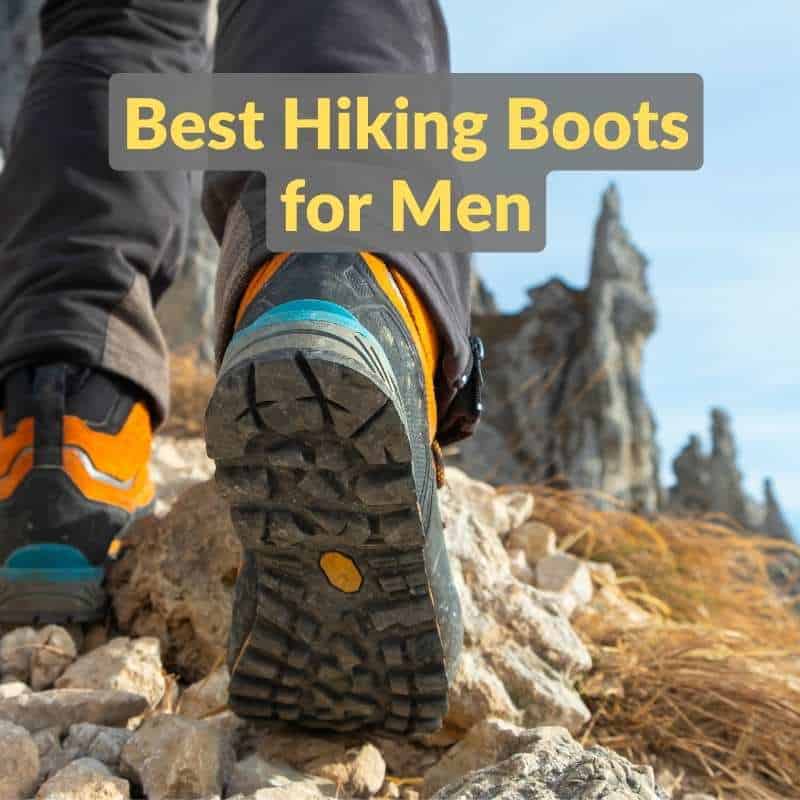

Pingback: Best Hiking Boots for Men in 2023 - Will Hawkins - Outdoor Adventure
Pingback: Best Hiking Boots for Men (in 2022)
Pingback: Are Hiking Boots Safety Boots? - WB Hawkins
Pingback: Find the Top 10 Best Hiking Socks - UK (2023 Edition)
Pingback: Beat the Downpour: 15 Best Waterproof Hiking Trousers [2023]
Pingback: 12 Best Hiking Boots for Women (in 2022)